ITECH2002 Systems Modelling Assignment
- Subject Code :
ITECH2002
- University :
Federation University Exam Question Bank is not sponsored or endorsed by this college or university.
- Country :
Australia
Section 1: Multiple Choice Questions [10 x 1mk = 10 mks]
Instruction: All questions in this section have only one valid answer, unless specified.
Question 1.
A system is a collection of interrelated components that function together to achieve some outcome.
- True.
- False.
Question 2.
Systems analysis involves the creation of:
- logical models.
- physical models.
- database designs.
- software class designs.
Question 3.
A fact finding user interview can usually be completed in one comprehensive session.
- True.
- False.
Question 4.
A systems analyst can discover use cases by using either a user goal technique or event decomposition technique. Before using the user goal technique the analyst must first:
- find the goals.
- Identify and classify all users.
- make appointments with users.
- none of the above.
Question 5.
Throughout the semester, we have looked at RMO as our example case study. In the OrderEntry subsystem, which of the following are considered as non-functional requirements:
- Look up item availability and create new order.
- Produce transaction summary report in electronic format first and hard copy as an option.
- Allow 100 customers to place orders at any one time and customers must be able to view order status as soon as the orders are recorded.
- All of the above.
Question 6.
What is a use case diagram?
- One method for documenting functional requirements.
- One method for documenting non-functional requirements.
- An activity that the system performs as a result of some action by a user.
- None of the above.
Question 7.
When drawing a use case diagram, an actor is always outside of the automation boundary.
- False.
- True.
Question 8.
A domain model class diagram has attributes. An attribute that contains a collection of related attributes is called:
- a class attribute.
- key attribute.
- compound attribute.
- association attribute.
Question 9.
In a design class diagram, a class has attributes and methods. What is a method?
- The name of the class.
- The development environment used for writing the software.
- Part of a program - it is what programmers have to write. In ITECH2001 - Fundamentals of Game Development, they are part of a script.
- None of the above.
Question 10.
When designing a top level menu, an initial grouping of cases by actor and subsystem is a good starting point.
- True.
- False.
Section 2: Free form Answers [50 mks]
Question 11. [5 x 2mks = 10 mks]
- What is a model and give two reasons why a systems analyst might create a model.
- Explain the difference between operational and executive stakeholders.
- Explain the difference between a system sequence diagram and a sequence diagram.
- Describe how structured analysis view of a system differs from object-oriented analysis.
- Briefly explain what is meant by Dialog Metaphor in Human Computer Interaction.
Question 12. [1 + 4 + 5 mks = 10 mks]
- What is the difference between a static and a dynamic model in UML.
1 mk - Identify which of the following UML models are static and which models are dynamic.
[4x1mk]
[static/dynamic]
Domain model class diagram.
[static/dynamic]
State diagram.
[static/dynamic]
Activity diagram.
[static/dynamic]
System sequence diagram.
Continued on the next page - Throughout the semester, we have looked at RMOs Consolidated Sales and Marketing System (CSMS) case study, which has four subsystems: sales, order fulfillment, customer account, and marketing subsystem. Some of the functionality of CSMS are listed below. Tick those use cases that satisfy the elementary business process (EBP) concept and justify why they satisfy this concept or why they do not.
[5x 1mk]- Create a new order
- Generate a new order number.
- Process order.
- Create a new customer.
- Print end of month order summary report.
Question 13. [4 + 6 = 10 mks]
- Explain the concept of a perfect technology assumption and how it affects the requirements analysis and design of an information system.
[4 mks]
See the next page.. - The system sequence diagram below shows the process of applying for a credit card. Using the diagram, answer these questions:
[3 x 2mks]- Identify the inputs to the system and outputs from the system.
- Under which conditions does the system reject a credit card application?
- Whose application(s) will be accepted or rejected? Justify your answers.
Joe, weekly income $600 and total weekly cost is $200.
Jim, weekly income is $1000 and total weekly cost is $600.
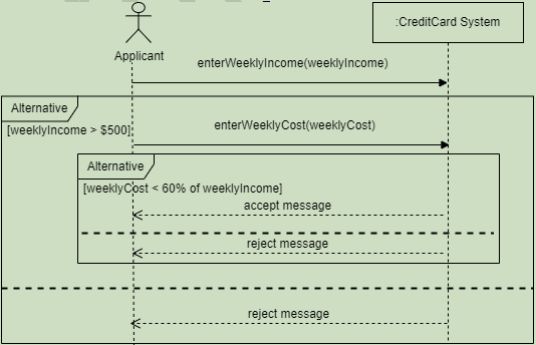
Question 14. [4 + 4 + 2 = 10 mks]
A class diagram is one of the most widely used UML diagram. During the analysis, it is known as the domain model class diagram (which you have submitted as part of assignment 1).
- Explain what information is captured in a domain model class diagram.
[4 mks] - What is an association class and why is it needed? Illustrate your answer using an example and a diagram.
[4 mks ] - A state machine can sometimes be in a concurrent state. Explain what is a concurrent state and give an example
[2 mks ]
Question 15. [4 + 2 + 4 = 10 mks]
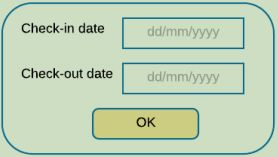
- Write four test cases (including the test description, test data and expected result) to test the validity of checkInDate and checkOutDate in the following screen. The two dates identify the booking period of a hotel room.
[4 mks ]
The input program guarantees that the format of dates are always valid, such as users can only enter 1 to 28, 29, 30 or 31 as days, depending on the month; and 1 to 12 for the month. Assuming that today is 1st June 2018, write four test cases that check the validity of dates as dictated by the following business rules:
- Customers can not check-in earlier than today, but can check-in today.
- Customers must stay for at least one night: check-out date must be at least one day after the check-in date.
Section 3: Modelling Tasks [40 mks]
Acknowledgement: the case study for the modelling tasks is inspired by Myki.
Some of the services may have been added, and some procedures have been simplified or modified to satisfy certain learning outcomes.
3.1 About Myki
Myki is the reusable travel card for trains, trams and buses in Melbourne and regional Victorian centres. A similar system may be operating in your city or country of residence, but please use the description here when answering the questions. For simplicity, we will exclude the detail of fare calculation because it is quite complex.
3.2 Description
Train stations in Victoria, Australia, are divided into zones as described in Figure 1 below
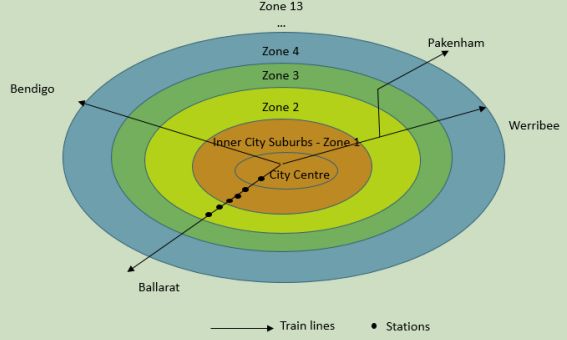
Figure 1. Zoning systems of train stations in Victoria, Australia. Each train line has a name and starts or ends at the city centre, and each zone may have multiple stations.
Metropolitan train stations are divided into two zones: zone 1 for the city center of Melbourne and inner city suburbs, zone 2 is for outer Melbourne suburbs. Regional centres have different zones and can go up to zone 13.
Regional and metropolitan buses are also divided into the zoning system following the zoning description above. Each bus route has a name and maximum number of stops, and each bus could travel up to two zones only, say zone 1 to zone 2 or zone 12 to zone 13.
All travellers must use Myki cards when travelling. A new Myki can be used for four years from the time it is activated, which is the first time credit is added (first top up). Expired or nearly expired cards can be replaced; lost cards can also be replaced.
Myki cards can be divided into two broad categories: Myki money or Myki pass.
- Myki money stores the balance of credit (amount of money left on the card). If travelling using Myki money, then fares are deducted at end of each travel. Travellers can top up Myki cards anytime as long as it is within four years since it was activated and has not been replaced.
- A Myki pass stores the date and zones purchased, say zone 1 to zone 4. If travelling using a Myki pass, travellers can legally travel up to the date they have purchased the pass for within certain zones. For example, if a traveller bought a 7 day Myki pass on 1st January, 2018 for zone 1 to 4, then the traveller can travel legally within zone 1 to 4 until 7th January, 2018.
Travellers can purchase 7 day, 28 day or yearly passes. Travellers can also extend Myki pass anytime, as long as the card is less than four years since it was activated and has not been replaced. If a Myki pass has been purchased up until 7th January and another 7 day pass is purchased on 5th January, then the last legal travel date is 14th January.
Both Myki pass and Myki money have four broad sub-categories: full fare, concession, children or seniors. So, in total, there are eight types of cards: full fare Myki money, concession Myki money, children Myki money, seniors Myki money, full fare Myki pass, concession Myki pass, children Myki pass and seniors Myki pass.
A traveller can also register their Myki card(s) by creating a Myki account and provide his/her name, a phone number and date of birth. An account must be linked to at least one Myki card and at most eight Myki cards. Each Myki card must have the name and date of birth of the card holder. If the account holder is also the card holder, then the account holder must also provide the name and date of birth for the Myki card to be registered. This allows the account holder to check the Myki money balance (or Myki pass last legal travel date and zones) and travel history, and replace cards on-line. When replacing a card, the balance; or legal travel dates and zones from the replaced card will then be transferred to the new card. The status of the card that has been replaced will be changed to invalid.
To start a journey, simply touch on by tapping the Myki card on a Myki card reader and this will change the status of the card to touched on. The Myki system then records the name of the train station, zone and date and time when the journey starts. At the end of the journey, simply tap the card again to touch off and this will change the status of the card to touched off. In cases where travellers forget to touch off, the system will add the last travel zone to be the last zone on the train line or bus route and the touch off time to be two hours since touch on.
Questions are on the next page
Question 16. [1 + 2 + 2 = 5 mks]
- A MykiCard class is the class that stores information about a card, including the status of the card. List all four valid states for the status of a card.
[1 mk ] - List all events that trigger the change to the card status.
[2 mks ] - Draw a state machine diagram for the MykiCard class.
[2 mks ]
Question 17. [5 + 5 + 5 = 15 mks]
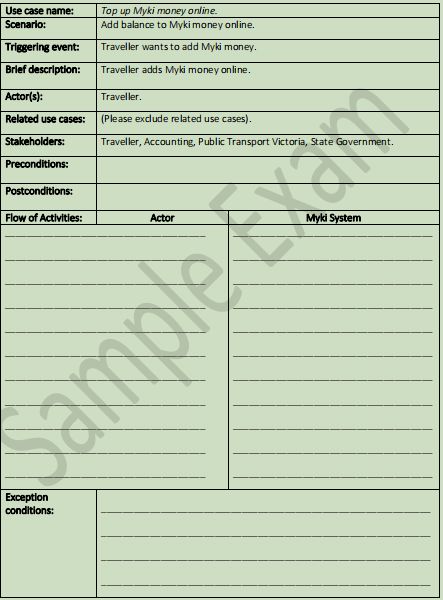
- Draw an activity diagram for the full use case text developed in section (b).
[5 mks ]
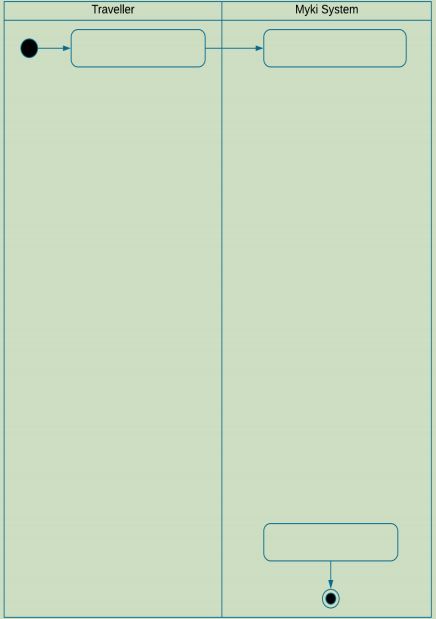
Question 18. [5 + 15 = 20 mks]
This question requires you to develop a domain model class diagram based on the description of the case study (Myki System).
- Circle all the nouns in the case study Section 3.2 which are candidates for attributes or classes.
[5 mks ] - Draw a domain model class diagram (including the MykiCard class from Question 16a). Each class must have appropriate attributes. The class diagram must have multiplicity information and use appropriate relationships, such as association, inheritance, composition or aggregation whenever appropriate. [15 mks ]
Are you struggling to keep up with the demands of your academic journey? Don't worry, we've got your back! Exam Question Bank is your trusted partner in achieving academic excellence for all kind of technical and non-technical subjects.
Our comprehensive range of academic services is designed to cater to students at every level. Whether you're a high school student, a college undergraduate, or pursuing advanced studies, we have the expertise and resources to support you.
To connect with expert and ask your query click here Exam Question Bank

